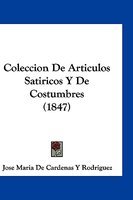2.4.1 The cultivation of the article of customs by José María de Cárdenas y Rodríguez (1812 – 1882)

José María de Cárdenas y Rodríguez was a disciple of José Antonio Saco and a friend of Félix Varela, whom he met while studying in the United States. After several years living in that country, he settled permanently in Havana.
Under the pseudonym Jeremías de Docaransa, he began publishing articles on customs and satire, as well as some poetry, in newspapers and magazines, including “La Prensa,” “Faro Industrial de la Habana,” “Flores del Siglo,” “Revista de la Habana,” and others.
He had a very good command of the Spanish language, which he used to describe in an entertaining way the interweaving of customs that were evident in the various social strata. His critical vision is sometimes admonitory but is always interspersed with a healthy sense of humor, even when his aims were clearly didactic, and this diminished a certain aesthetic value of his prose.
In 1847, his first book, containing works published since 1838, was printed under the title “Collection of Satirical and Customary Articles,” with a prologue written by Cirilo Villaverde. These and those published in the anthology “Cubans Painted by Themselves” demonstrate the author’s elegant style and a refined sense of humor that addresses sensitive issues in nineteenth-century society.
One of the issues that most concerned him was the education of children, which he emphasized the need to instill standards of conduct and provide appropriate role models for parents, who had the ultimate responsibility for their children’s behavior.
It was for these articles that the author achieved renown; however, he also published fables, ditties, and epigrams, in addition to writing two comedies: “No siempre el que echos acerta” (The One Who Chooses Is Right) in 1841, and “Un tío sordo” (A Deaf Uncle) in 1848. A didactic and moralizing purpose is present in almost all of his works, based on a very Creole humor that, rather than admonishing, aims to serve as an element of social regeneration.








